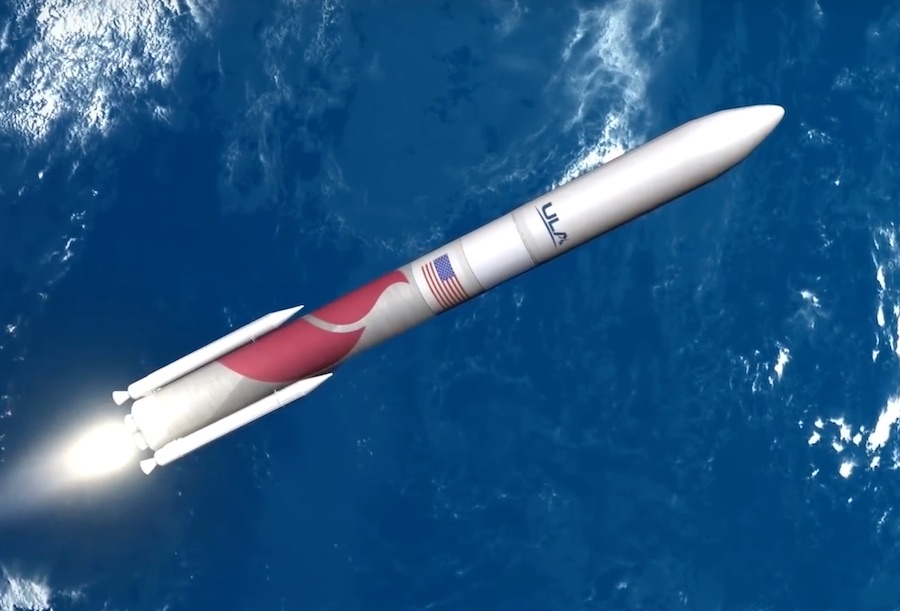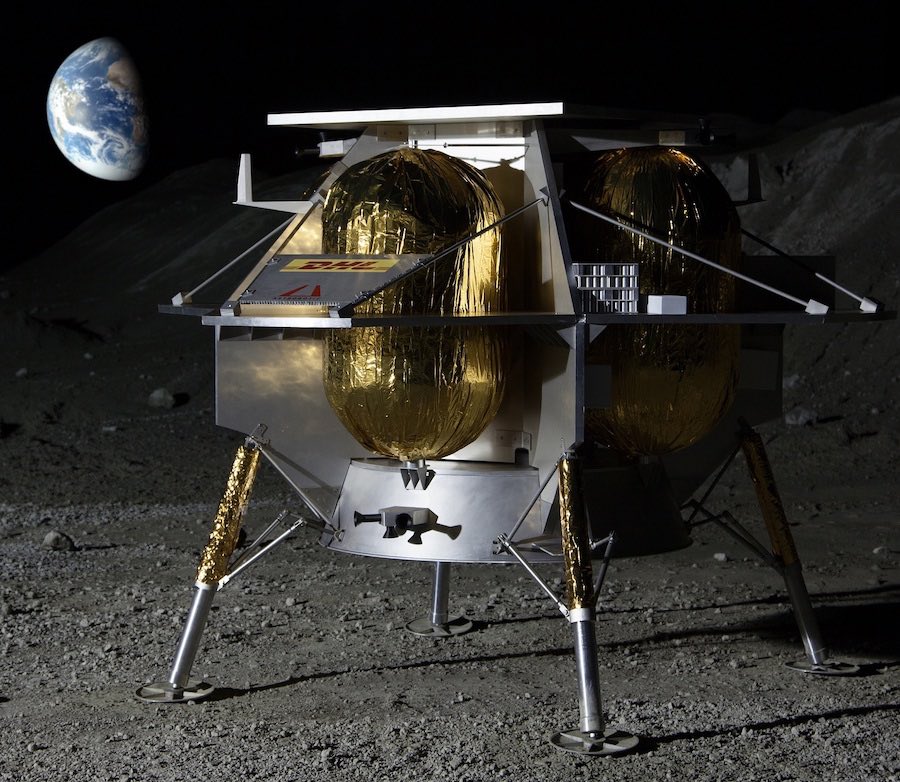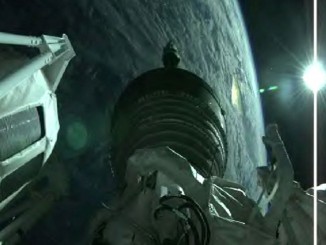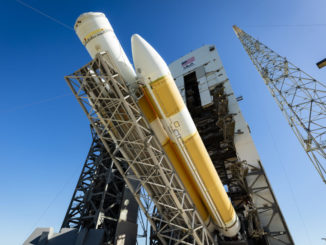
Astrobotic, a Pittsburgh-based company developing a robotic lunar lander, will launch its first moon mission under contract to NASA on the debut flight of United Launch Alliance’s Vulcan Centaur rocket in 2021, officials announced Monday.
If successful, Astrobotic’s Peregrine spacecraft could become the first U.S. spacecraft to achieve a soft landing on the moon since the last Apollo crew lifted off from the lunar surface in 1972.
“It’s been 12 years building the company, and to be at the point where we are now on contract aboard a ULA flight to the moon is pretty darn exciting for us,” said John Thornton, Astrobotic’s CEO. “It’s a big momentous occasion for the company and marks the beginning of our official countdown clock for launch.”
The financial terms of Astrobotic’s contract ULA were not disclosed, but Astrobotic said its selection of ULA’s Vulcan Centaur for the launch of the Peregrine lander was the result of a “competitive commercial procurement.”
The Peregrine lander’s mission to the moon will carry up to 14 scientific and technology demonstration payloads from NASA, which contracted with Astrobotic through the agency’s Commercial Lunar Payload Services, or CLPS, program.
Thornton said the CLPS program requirements limited Astrobotic’s launch options to U.S. companies.
“You can probably guess the U.S. launchers we were looking at,” Thornton said in an interview with Spaceflight Now. “I don’t want to name them specifically.”
Earlier this year, Thornton said Astrobotic was looking at ULA or SpaceX to provide the launch for the first Peregrine lander.
“ULA’s been very supportive to us over the years, and helpful with engineering, general business support and technical expertise through the course of development, and when it came time to buy a launch, we of course gave ULA an opportunity to bid,” Thornton said. “And we also looked around at other opportunities because it is a pretty big purchase. So we looked around, but at the end of the day, ULA had the best business option for us, and we went for it.”
The Peregrine lander will be on Vulcan launcher’s first mission when it blasts off from pad 41 at Cape Canaveral Air Force Station in 2021. The Vulcan is the replacement for ULA’s Atlas and Delta rocket families.
“Our rockets have carried exploration missions to the moon, the sun and every planet in the solar system so it is only fitting that Vulcan Centaur’s inaugural flight will lead the return of Americans to the lunar surface,” said Tory Bruno, ULA’s president and CEO. “We could not be more excited to fly this mission for Astrobotic.”
Thornton confirmed to Spaceflight Now that Astrobotic will share the Vulcan rocket with other spacecraft on a multi-payload launch, but he declined to describe the Peregrine as a primary or secondary payload. ULA has not announced the identities of other spacecraft slated to ride the first Vulcan Centaur into space.
The first Vulcan Centaur flight will launch in a configuration with two strap-on solid rocket boosters built by Northrop Grumman. The Vulcan’s core stage, powered by two Blue Origin BE-4 engines, will be augmented by zero, two, four, or six solid-fueled boosters on each flight.
Monday’s announcement by ULA and Astrobotic came less than a week after Sierra Nevada Corp. selected the Vulcan Centaur to launch at least six Dream Chaser resupply missions to the International Space Station, beginning in late 2021.
Like Astrobotic’s Peregrine lander, the Dream Chaser missions are commercially-managed but will fly under contract to NASA.
The first Dream Chaser mission will launch on the second Vulcan Centaur flight, following a few months after the inaugural Vulcan launch with the Peregrine moon lander.
Astrobotic and ULA announced in 2017 a previous agreement to launch the Peregrine lunar lander on Atlas 5 rocket in 2019. Development delays at Astrobotic kept that from happening, but the Pittsburgh company now has NASA as an anchor customer.
“This partnership represents a true ‘whole-of-government’ approach to how our nation is leading the world in space: NASA contracted with a commercial company to land on the Moon, who then went on to contract with a commercial company for a rocket built to serve the national security space market,” Bruno said in a statement. “This highlights the power of our American system of partnership between government and industry to solve the toughest problems and the greatest of our human aspirations.”

NASA awarded Astrobotic a $79.5 million contract in May in the first round of mission orders through the CLPS program. The space agency selected nine U.S. companies, including Astrobotic, last November to compete for CLPS contracts to ferry NASA-sponsored science instruments and tech demo payloads to the moon.
The CLPS program is a precursor to NASA’s plans to return humans to the lunar surface, a goal Vice President Mike Pence directed NASA to accomplish by the end of 2024.
Along with Astrobotic, NASA in May selected Intuitive Machines and OrbitBeyond to deliver science instruments to the moon. NASA terminated its $97 million contract with OrbitBeyond in July due to “internal corporate challenges” at the company.
The Nova-C lander developed by Intuitive Machines is scheduled to land on the moon in July 2021, on roughly the same schedule as Astrobotic. At the time of the May contract announcement, Intuitive Machines said it plans to launch the Nova-C lander as the primary payload in a multi-mission rideshare mission aboard a SpaceX Falcon 9 rocket.
Astrobotic once competed for the defunct Google Lunar X Prize, which ended last year without a winner.
Dynetics is supporting development of the propulsion system for the Peregrine lander, a robotic craft that will stand roughly 6.2 feet (1.9 meters) tall and 8.2 feet (2.5 meters) wide. The first Peregrine mission will target a landing in July 2021 at Lacus Mortis, a large crater with a surrounding lava plain on the near side of the moon.
According to a user’s guide published by Astrobotic earlier this month, the Peregrine lander will weigh nearly 2,900 pounds (1,313 kilograms) fully fueled for launch.
Thornton said the Vulcan rocket’s Centaur upper stage, with two Aerojet Rocketdyne RL10 engines, will boost the Peregrine spacecraft on a trans-lunar injection, or TLI, trajectory directly to the moon. Astrobotic previously considered an alternative launch trajectory, in which a rocket would drop off the Peregrine spacecraft into an elliptical orbit around Earth. In that case, the Peregrine spacecraft would have used its own engines to propel itself toward the moon.
“This would actually be effectively a TLI from launch,” Thornton said. “When the launch vehicle lets go, we are flying toward the moon. So their job is to get us out flying toward the moon. Our job is to brake when we get out there, descend into lunar orbit, and then soft land on the moon.
“GTO (geostationary transfer orbit) was always in the trade space as was TLI, so we were happy that TLI ended up being the one selected because that matches up best with our spacecraft,” he said.
Astrobotic says the Peregrine lander will accommodate up to 200 pounds (90 kilograms) of payloads on its mission to the moon. The spacecraft is designed to survive at least eight days after landing.
Up to 14 NASA instruments and 14 commercial and international payloads will fly on the Peregrine’s first mission. Astrobotic is still taking on customers who want to put their payload on the 2021 landing mission.
“We are (accepting more payloads) for a very short time, for maybe a month, or maybe two,” Thornton said. “It really depends on the type of payload. But the window is closing really fast. We have a lot of late comers, and we need to finalize the spacecraft before we head off to flight, so we just have a handful of kilograms left.”
The Peregrine is the first of a family of landers planned by Astrobotic. In May, Thornton said Astrobotic is “fully funded” for the first Peregrine mission.
Thornton said Monday that the Peregrine’s first mission is scheduled for launch in June 2021. ULA has been targeting April 2021 for the first launch of the Vulcan Centaur rocket. It was not immediately clear which schedule target was most up to date.
“We’re on schedule for summer 2021,” Thornton said Monday. “We are, right now, ordering long-lead items. We are finishing our integrated avionics unit and flight computer. We’re also getting ready to build our structural test model, as well as gearing up for our critical design review toward the end of this year.
“So we’ve got a lot on our plate,” he said. “We’ve been hiring and adding a lot of new positions to the company. Things are going very well on that front.”
Astrobotic currently has a staff of 27 employees, but more workers are joining the company every week, Thornton said.
Email the author.
Follow Stephen Clark on Twitter: @StephenClark1.



